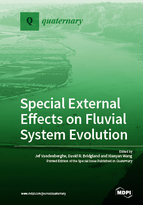Special External Effects on Fluvial System Evolution
A special issue of Quaternary (ISSN 2571-550X).
Deadline for manuscript submissions: closed (15 July 2018) | Viewed by 47200
Special Issue Editors
Interests: fluvial geomorphology; morphological evolution; fluvial sedimentology; aeolian sediments; periglacial landforms
Special Issues, Collections and Topics in MDPI journals
Interests: quaternary stratigraphy; fluvial archives; palaeolithic; landscape evolution; geo-conservation
Special Issues, Collections and Topics in MDPI journals
Interests: fluvial processes and landforms; gemorphic responses; drainage evolution; tectonic geomorphology
Special Issues, Collections and Topics in MDPI journals
Special Issue Information
Dear Colleagues,
Rivers are excellent witnesses of the dynamics affecting the Earth’s surface environments. They are highly sensitive to climate change, base-level change, tectonic movements and human influence. In addition, the complexity of this external forcing to fluvial dynamics has to be supplemented with internal mechanisms. Fortunately, rivers are reliable recorders of these dynamics via their sedimentary products and morphological expression, which may be considered as fluvial archives.
Until now there was a focus on evaluating the general impacts of individual external factors. However, specific environmental characteristics of these factors have been shown to be increasingly important by recent case studies. For example, the effects of regional climate, differentiated topography and vegetation, and frozen ground appears to play an essential role in the evolution of the fluvial system. Integration of such environmental conditions in the processes that were active within the complex fluvial system will open new perspectives in the progressive understanding of the evolution of landscape form, ecology, sediment fluxes and hydrology of the system, within the framework of external drivers, such as tectonics, general climate and human activity. This is an appealing challenge that we want to address in the present Special Issue under the aegis of the Fluvial Archives Group (FLAG) under the title “Special External Effects on Fluvial System Evolution”.
Prof. Jef Vandenberghe
Prof. David R. Bridgland
Dr. Xianyan Wang
Guest Editors
Manuscript Submission Information
Manuscripts should be submitted online at www.mdpi.com by registering and logging in to this website. Once you are registered, click here to go to the submission form. Manuscripts can be submitted until the deadline. All submissions that pass pre-check are peer-reviewed. Accepted papers will be published continuously in the journal (as soon as accepted) and will be listed together on the special issue website. Research articles, review articles as well as short communications are invited. For planned papers, a title and short abstract (about 100 words) can be sent to the Editorial Office for announcement on this website.
Submitted manuscripts should not have been published previously, nor be under consideration for publication elsewhere (except conference proceedings papers). All manuscripts are thoroughly refereed through a single-blind peer-review process. A guide for authors and other relevant information for submission of manuscripts is available on the Instructions for Authors page. Quaternary is an international peer-reviewed open access quarterly journal published by MDPI.
Please visit the Instructions for Authors page before submitting a manuscript. The Article Processing Charge (APC) for publication in this open access journal is 1600 CHF (Swiss Francs). Submitted papers should be well formatted and use good English. Authors may use MDPI's English editing service prior to publication or during author revisions.
Keywords
- fluvial archive
- fluvial evolution
- fluvial system








